This Flying ATV Might Bring Farming Into a Cyberpunk Future
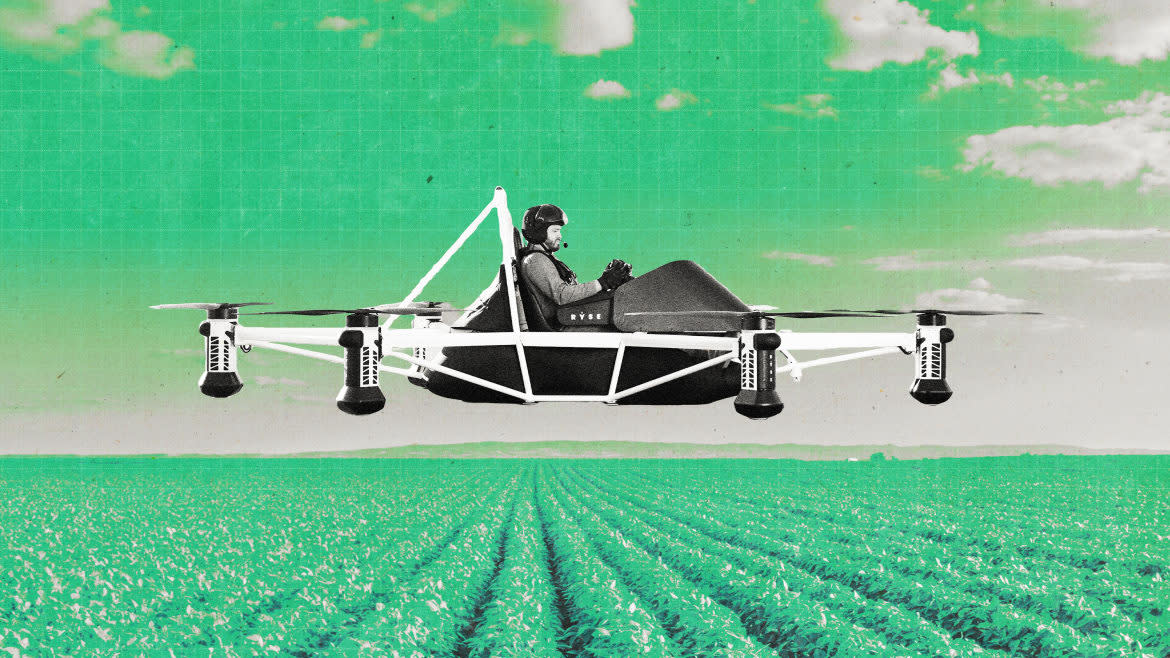
It’s easier to operate a flying ATV than you think—or, at least it was for me. That’s not a humblebrag either. It was designed so any idiot like me—who backs up into his recycling bin every time he pulls out of the driveway—can jump in and use it.
Making sure I fly without freaking out, though, was another question entirely.
“Alright, you’re doing great,” the voice of Mick Kowitz, the CEO and founder of RYSE Aero Technologies, chirped in my ear via a radio relay in my helmet. “Now just pull back on the left handle and press the button to take off.”
The machine I was sitting in—dubbed the RECON—is known as an electric vertical takeoff and landing (eVTOL) aircraft and it’s Kowitz’s brainchild. While not technically a flying ATV, it’s pretty damn close. As I pulled back on the handle, six battery powered propellers whirred to life around me and my seat began to rumble. Images of the new Top Gun movie flashed in my mind’s eye before a macabre intrusive thought popped into my head: If I stuck out my arm just a little bit, I’d sever my hand entirely from my arm. A shiver ran down my spine as I attempted to bury the mental image.
I pressed the takeoff button on the center console. For a moment, nothing happened. As I was about to tell Mick that something was wrong, though, the motors whirred louder as the RECON lurched sideways. Before I could react, I felt a weight on my chest and my heart jump into my throat as it lifted me off the ground and into the sky.
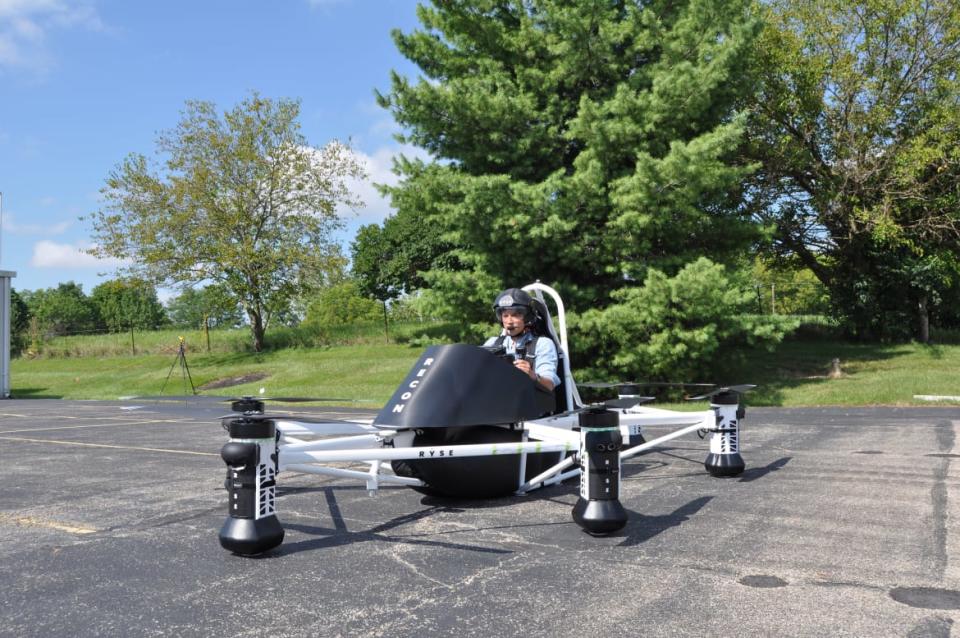
The Daily Beast’s intrepid reporter tests out the RECON for himself.
Though I was piloting the craft that day, “nervous journalists on field reporting trips” aren’t exactly the target demographic for RYSE. In fact, Kowitz told me that he wanted to put the aircraft into the hands of a much different and unexpected kind of person: farmers and ranchers. Other eVTOL companies like Joby Aviation and Vertical Aerospace have their sights set on private transportation (think flying Ubers and Lyfts), while others are focused on building the aircrafts for military and defense.
RYSE, on the other hand, is focused on an industry that Kowitz claims has always been on the forefront of innovation and technology—despite public perception otherwise.
“We tend to think of farmers and put them in the bucket of hillbillies, but I picked them for the exact opposite,” Kowitz said. “They’re actually the most innovative users in the world. They’re the first to use fully autonomous equipment in the market like tractors that run on GPS for the last 20 years. Nobody was doing that. Tesla’s only had autopilot in their cars for eight years.
“Then there’s tracking fields and soil, doing high-definition imaging and topography analysis—farming’s very sophisticated science,” he added. “These guys are used to using high tech before everyone else.”
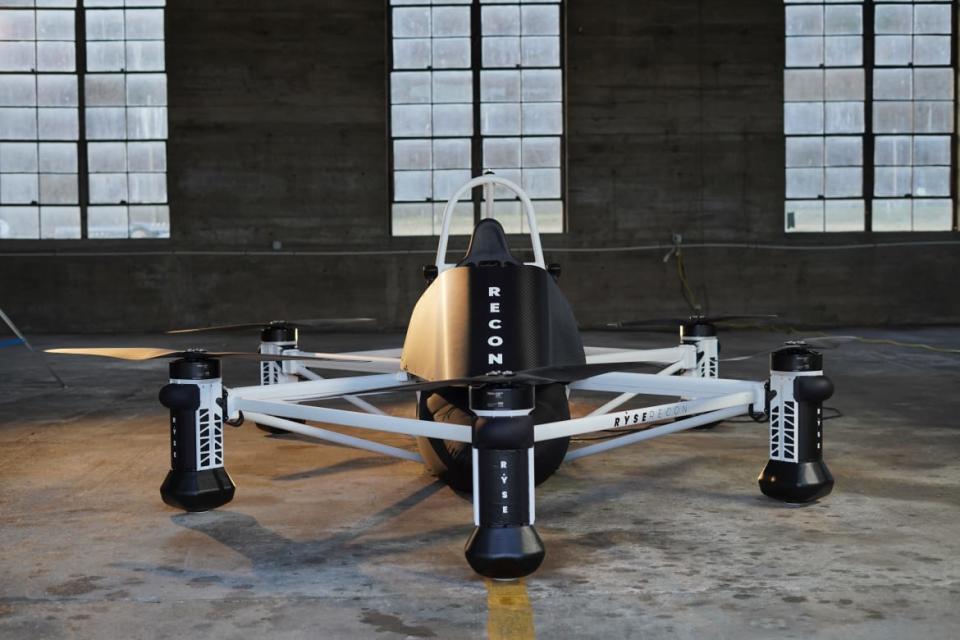
The RECON can fly as high as 400 feet and as fast as 63 miles per hour, and is slated to retail at $150,000.
That’s why Kowitz believes that farmers, ranchers, and other folks in rural communities can largely benefit from a machine like the RECON. These are people who own hundreds if not thousands of acres of land, farms and fields that need to be regularly maintained and analyzed. If there are animals grazing on it, a farmer might need to be able to get out there quickly to help their livestock in case of emergencies.
Currently, the only way to do that is to walk, drive via a truck or a utility vehicle, ride on a horse, or—if you have a lot of money—fly in a helicopter or fixed wing plane. All those options can be an incredible drain on time and money, or even pose a direct threat to the land outright (you don’t want to be driving over your crops).
“Being able to take a vehicle like this can get you out there as the crow flies,” Kowitz said. “If you have broken down equipment in the field, you could get there, repair it, and fly back.”
He told a story about a rancher in Colorado who had 20,000 acres for cattle. When the season approaches winter, roughly 80 percent of the herd comes back naturally to “get fed and be close to the ranch.” However, the other 20 percent remains out in the acreage.
“Every October, he has to send five cowboys out on horseback to come get those cattle. Those five can only cover about 20 miles a day because they’re at ground level,” Kowitz explained. “With this vehicle they can get up above to locate where they’re at and get people more efficiently where they are. They can save thousands of dollars just using it for location.”
Bill Seda will tell you himself that he’s not the most “cutting-edge farmer.” The 61-year-old grows corn and soybeans on 550 acres of land on his farm in Tama County, Iowa. He knows a little bit about the RECON, having heard about its upcoming appearance at the Farm Progress Show in Boone, Iowa on August 30. However, he's skeptical about the technology and how useful it could possibly be to him as a farmer—not to mention its price tag.
“I’m an old school type of farmer,” Seda told me. “Something new in innovation needs to be able to pay for itself in a decent amount of time. Some farmers like to have the newest and greatest toys, but if it doesn’t pay you back on your return on investment quickly then you lose money.”
He’s the exact type of farmer that RYSE needs to convince that a RECON—which is slated to cost $150,000—is a good investment. To do that, they need to address two of the biggest eVTOL challenges: battery life and safety (the same hurdles the electric vehicle industry faces).
The RECON and its six onboard batteries currently offer about 25 minutes of flight on a single charge, though that can change depending on a variety of factors including the weather, wind, density altitude, and the user’s weight. That could become a big problem for a farmer who needs to fly to a location that’s at least 15 minutes one way.
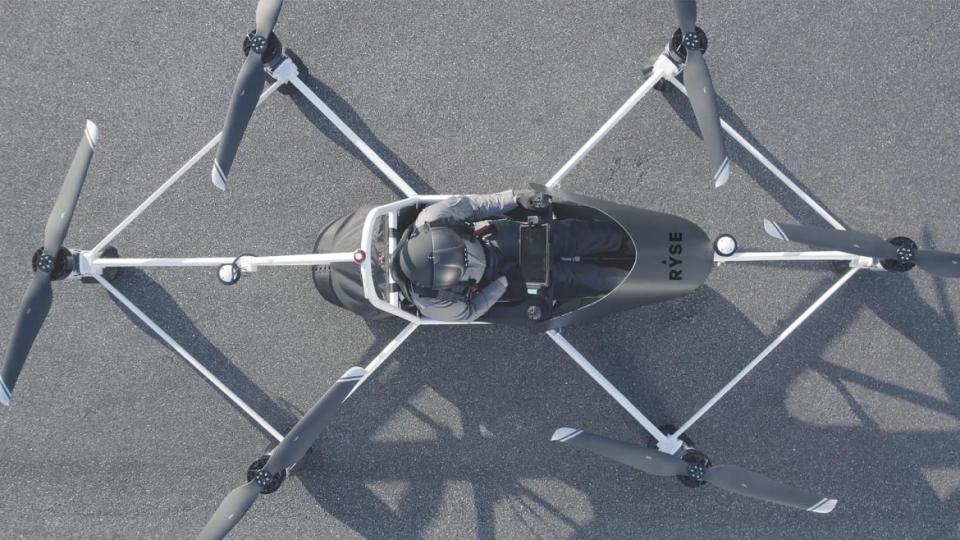
The RECON has a six battery-powered propeller design that Kowitz claims is safer than a helicopter and other eVTOLs on the market.
Kowitz said that this can be solved by stashing another set of fresh batteries in a location near to where you’d be flying, and swapping them out for the return flight.” Still, that requires even more money and time spent purchasing and installing kiosks and batteries throughout the land.
And that’s assuming there’s no fear of plummeting out of the sky. It’s safe to assume that the majority of farmers and ranchers don’t have previous piloting experience. And when you’re messing with an aircraft with six unprotected propellers, intrusive thoughts of being dismembered limb from limb aren’t that crazy.
However, Kowitz stressed that RYSE put user safety first when designing the vehicle. Part of it comes by way of the software, which uses AI to help keep the craft flying smoothly by responding to changes in the weather and altitude. Kowitz also said the propellers are even safer than a helicopter’s or other eVTOLs’. “A helicopter has a single point of failure because of its one rotor,” he said. “We have six and we put a lot of effort into building redundancy to make sure it’s not going to come down and get you hurt.”
Each propeller has a battery to power it, and even if one battery goes out, Kowitz said that the other batteries would support that propeller to keep it spinning. That way, you don’t just fall out of the sky if something happens and a rotor stops working.
The RECON gets around training requirements needed to get something like a pilot’s license, because the aircraft falls under the category of “ultralight aircraft” from the Federal Aviation Administration—anyone can jump into the RECON and start operating it pretty much right away. The company’s video tutorials that show the user how to operate the vehicle takes about 45 minutes to watch, said Kowitz. Users are still required to follow FAA regulations on where they can and can’t fly, like over airports or through cities; and payload restrictions.
That does mean the rules can be very easily broken, inadvertently or intentionally, for a vehicle flying 400 feet in the air and at 63 miles per hour. One dumb decision could cost you your life—and maybe the lives of others.
“Do I personally want to risk my life counting on a few batteries and a drone?” Seda asked. “I don’t know.”
I arrived at RYSE’s facility in Cincinnati, Ohio on a bright and sunny morning—optimal flying weather—I must have been wearing my nerves on my face, because Kowitz kept reassuring me how safe the machine was.
“I can tell you from personal experience: It’s boring,” he said. “I’m a pilot so I’m used to all the rigamarole of controlling an airplane but with this, it pretty much does all the workload for you. That’s kind of the point of it. It should be like hopping on an ATV, except you have an extra up-down dimension to it.”
Still, my own personal history with potentially dangerous transportation devices kept my anxiety at a fairly high level as I prepared for my ride in the RECON. Going through the instructions for how to fly the vehicle across an empty parking lot seemed easy to understand—the only question was would I be able to do it and survive.
After the training, I was given a flight helmet and we headed toward the lot where the RECON sat. There was a team of engineers for the company getting it ready. I felt like an Apollo astronaut heading towards a rocket destined for the moon. As I climbed in, I found the seat was smaller than I expected. I’m not that tall—just 6’ 1”—and I still struggled to fit my legs all the way in comfortably. The team strapped me in before taking their positions about 20 feet away to watch. I was on my own.
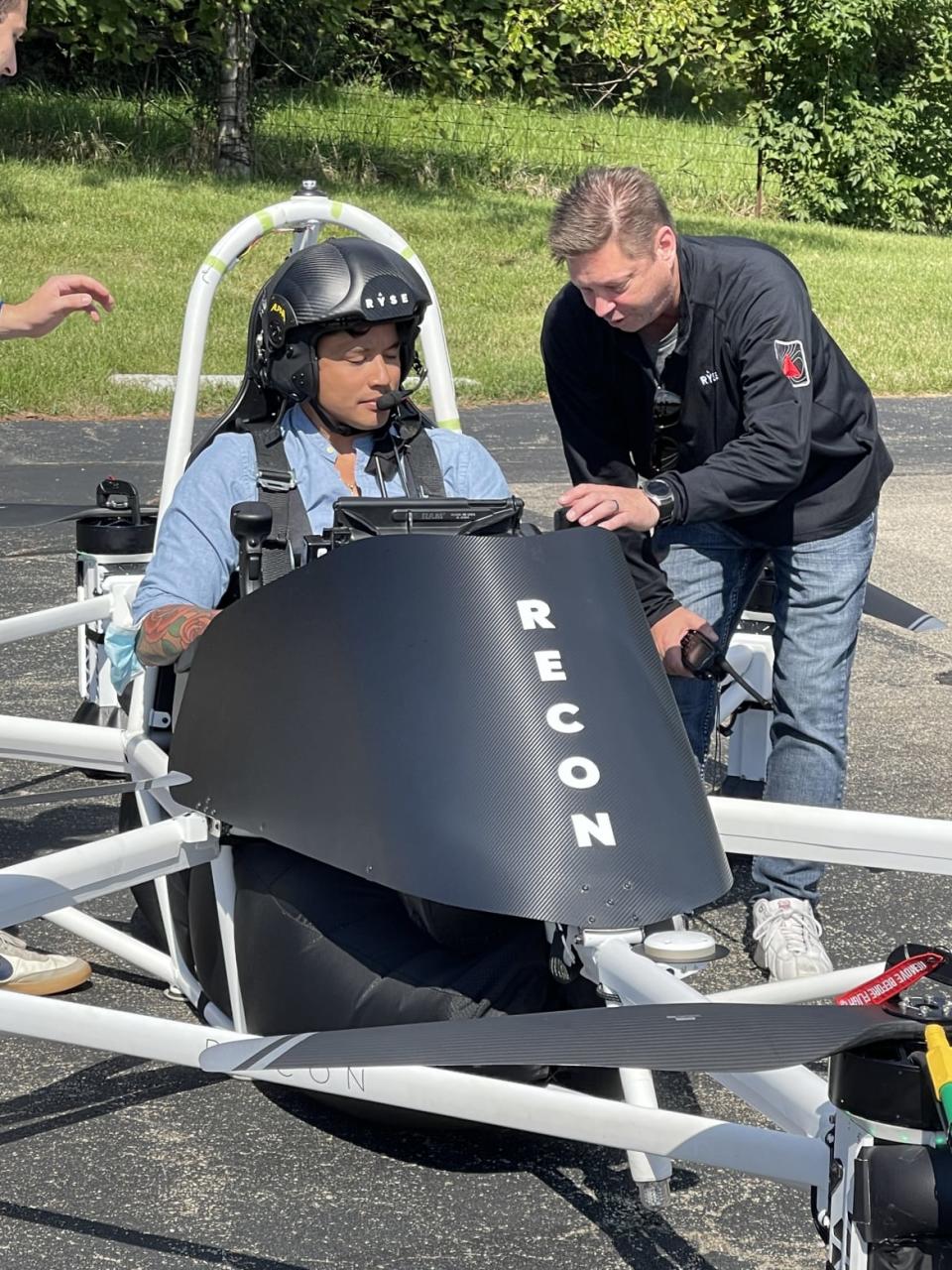
Kowitz helps me settle into the RECON.
I ran through a pre-flight checklist on the center console of things I needed to make sure of before I flew: no person or object within 20 feet of the RECON, clear weather, propellers in working order, etc. Once I got through it, it was time to fly.
Following the prompts on the console and from Kowitz, I pressed a few buttons and pulled back the lever before rising. It felt surreal as the RECON lifted into the air, like I was breaking some law of man and physics and god by doing this. Wind from the propellers whipped around me as I kept stopping myself from white knuckling the controls completely. Eventually, the vehicle climbed to a whopping 10 or so feet off the ground. While it was nowhere near the 400 foot ceiling, it felt like I might as well have been in orbit.
I tried to imagine what a farmer might think up here, trying to get a good look at her crops or find a lost calf, and I could almost see the value in this vehicle for the agriculture industry. And if RYSE could get farmers to buy into eVTOLs, the greater public might be more amenable as well. That’s still a long shot—but it’s possible.
“You’re doing great,” Kowitz said. “Now push the right controller forward.”
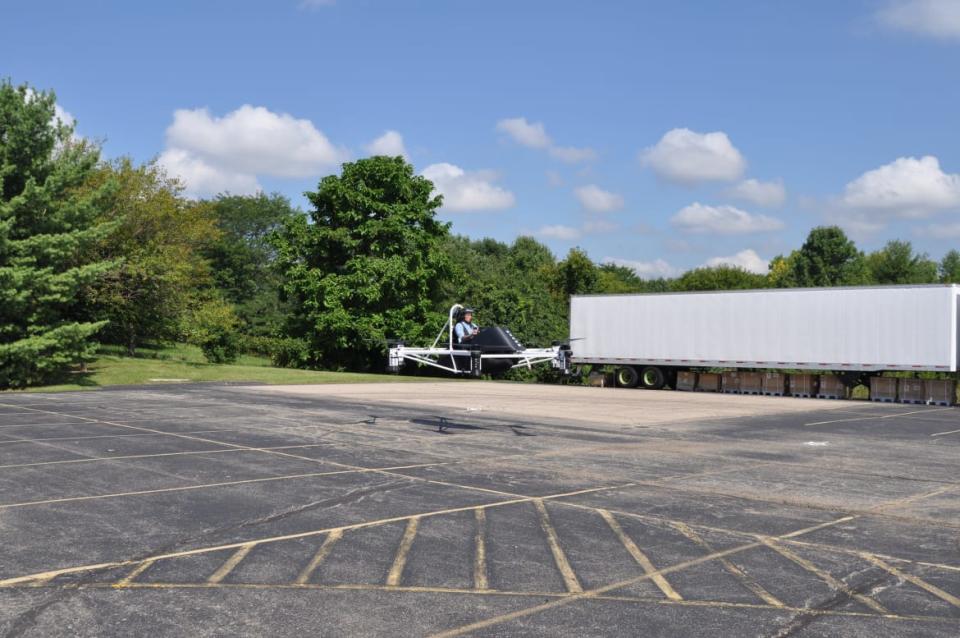
Eat your heart out, Tom Cruise!
I slowly eased it forward. As I did, the RECON moved slowly as well. I have to admit: it was pretty damn cool. Sure, I wasn’t breaking the sound barrier, but I was piloting an honest-to-god flying ATV. And I hadn’t died yet. It was awesome.
Eventually, I traveled the length of the parking lot and I pulled the left stick back to bring the RECON down. It landed somewhat gracefully, moving to an angle before settling down. Once the propellers stopped whirring, I heard the team cheer and clap for me—which I felt dumb for enjoying.
“How was it?” Kowitz asked after running up to me.
“Awesome,” I said as I climbed out and took off my helmet. “A lot easier than I expected. And you were right. It’s kind of boring.”
He laughed and nodded. “Yup, that’s the whole point.”
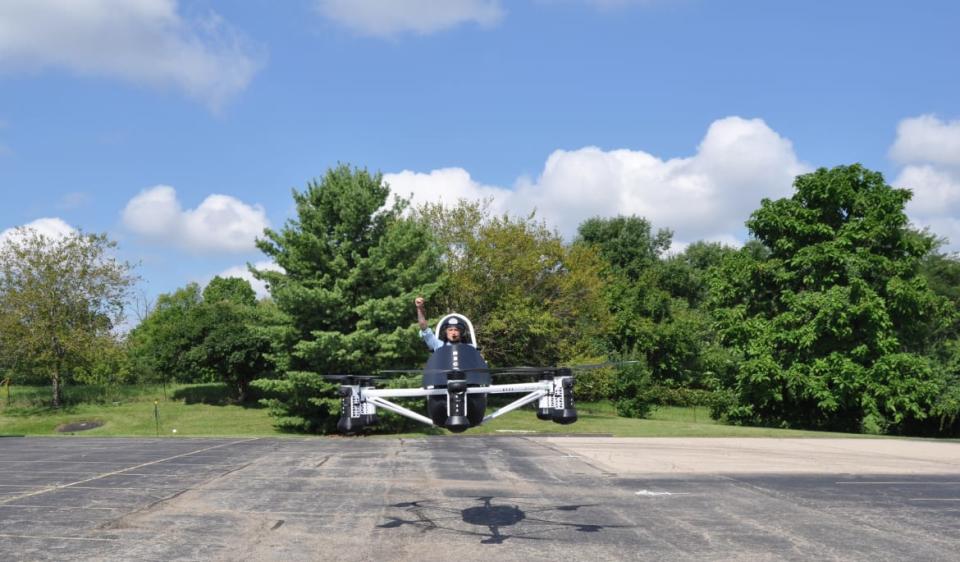
I feel the need. The need for speed.
Got a tip? Send it to The Daily Beast here
Get the Daily Beast's biggest scoops and scandals delivered right to your inbox. Sign up now.
Stay informed and gain unlimited access to the Daily Beast's unmatched reporting. Subscribe now.

